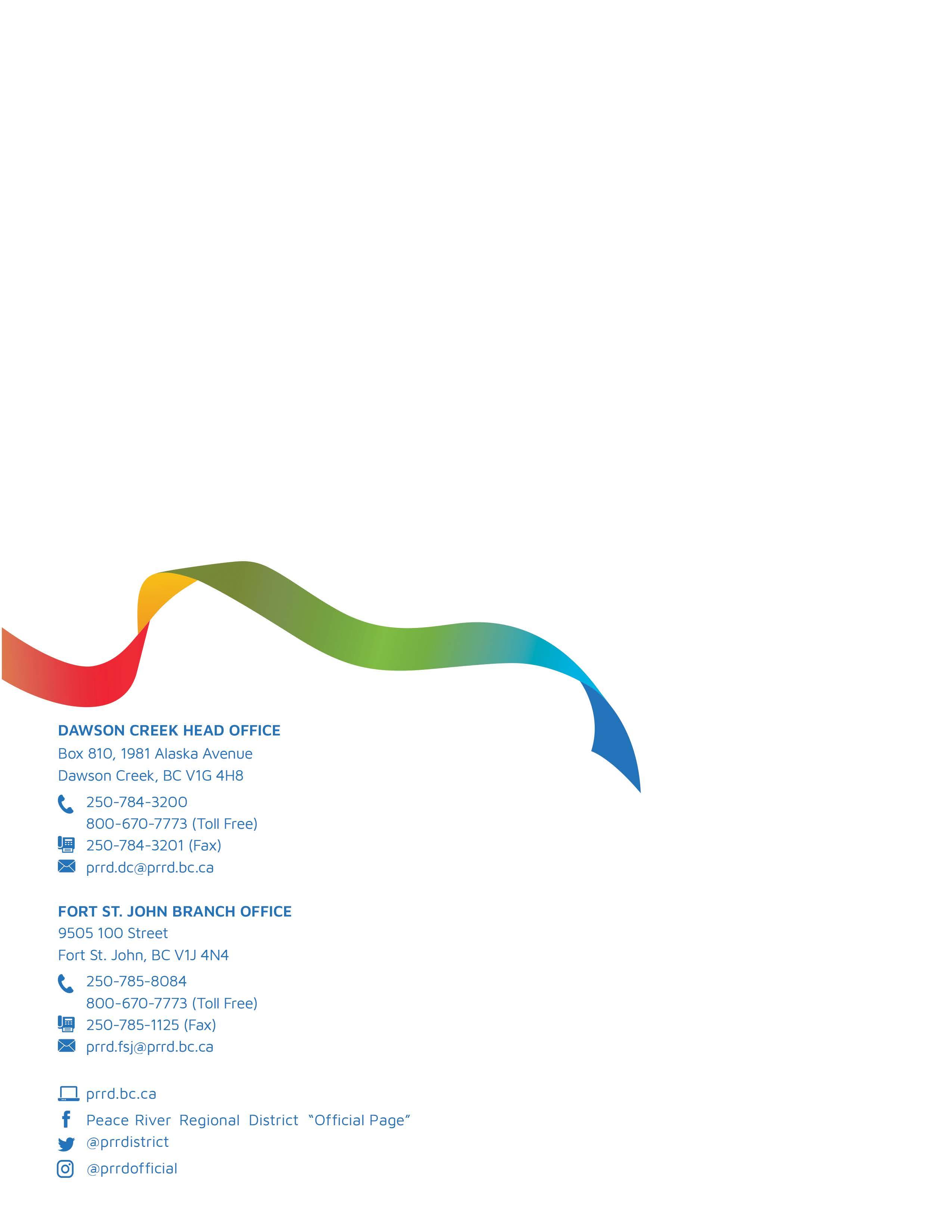






The 2023-2026 Strategic Plan is a guiding document that reflects the goals, priorities and objectives of the Peace River Regional District (PRRD) Board. The plan provides a roadmap for decision-making, resource allocation and helps to align the efforts of the organization and its employees. A well-crafted strategic plan is crucial to achieve long-term success by ensuring that the organization’s resources are concentrated toward a common and sustainable vision.
As a regional government, we provide leadership and use our influential, collective voice to advocate on behalf of our residents, businesses and industry in support of a prosperous economy, a healthy natural environment and resilient, inclusive communities. Over the next four years, the Board will focus on fiscal responsibility through infrastructure and asset management, best practices in human resources, collaboration and cooperation with First Nations and neighbouring local governments, responsive emergency management and advocating for the interests of the region.
The strategic plan is a living document that will adapt to the evolving needs of the organization and the citizens of the Peace River region; it may change through updates, be expanded as needed and serve a different purpose over time. Ultimately, the plan will support the Regional Board to engage with constituents and work together with First Nations and inter-provincial partners.
Chair Leonard HiebertPeace River Regional District





Regional districts emerged due to a need for greater regional cooperation and equitable cost sharing between municipal and rural areas.
A concept unique to British Columbia, regional districts are a federation composed of municipalities, electoral areas, and in some cases, Treaty First Nations. Each regional district is divided into smaller (mostly rural) areas called electoral areas, and these representatives join those from the member municipalities to form the Board of Directors.
Regional districts perform three primary functions:
• act as local government for their (unincorporated) electoral areas;
• provide the political and administrative frameworks necessary for member municipalities and electoral areas to collaborate in the provision of services; and,
• be the regional service body responsible for providing regional services to, and undertaking key activities on behalf of, their entire regions.

The Board of Directors for the Peace River Regional District and Hospital District are made up of twelve (12) Electoral Area and Municipal Directors.
Four (4) Electoral Area Directors are elected for a four-year term to represent the following rural Electoral Areas:
• Electoral Area ‘B’
• Electoral Area ‘C’
• Electoral Area ‘D’
• Electoral Area ‘E’
Eight (8) Municipal Directors are appointed by the councils of the seven member municipalities of the Peace River Regional District:
• District of Chetwynd
• City of Dawson Creek
• City of Fort St. John
• District of Hudson’s Hope
• Village of Pouce Coupe
• District of Taylor
• District of Tumbler Ridge


The Peace River Regional District is comprised of distinct and unique communities, each with their own strengths, values and aspirations. The region is shaped by its roots in agriculture and its culture of independence, resilience and compassion for others. With a thriving resource-based economy, an array of services and amenities and a variety of striking and inspiring landscapes, our residents enjoy a rewarding quality of life.
We see a bright and prosperous future for our region, while acknowledging the economic vulnerabilities of our resource sector and the impacts on our region from a changing climate. We will strive for diversity within our region’s economy; strong relationships with First Nations and other partners; and effective, responsive services that meet the needs of our residents and protect our communities from the increasing frequency of natural hazard events.
The PRRD plays a vital role in providing a variety of regional, subregional and local services that are valued by our residents and contribute to a high quality of life. We collaborate with other local governments, First Nations, agencies and volunteer organizations to deliver services and address challenges and needs in the region. As a regional government, we provide leadership and use our influential, collective voice to advocate on behalf of our residents, businesses and industry in support of a prosperous economy, a healthy natural environment and resilient, inclusive and liveable communities.

As we fulfill our obligations and responsibilities as a regional government, the PRRD will strive to:

• COMMUNICATE AND ENGAGE with our residents and stakeholders;
• COLLABORATE AND COOPERATE with our partners; and
• Be CONSISTENT in the application of our policies and decisions.
The Strategic Plan was developed by the Board to ensure that our decisions, activities and policies are in alignment with, and supportive of the Board’s vision and goals. The plan addresses the most significant opportunities and challenges facing the region and supports the continued provision of quality services, amenities and infrastructure for our residents.
The plan will inform the development of our annual budgets and departmental work plans. Quarterly reports to the Board and the Annual Report will provide an opportunity to review, communicate, and celebrate progress in achieving the Board’s goals and update the plan as necessary.

Goal
To effectively plan for and manage the PRRD’s assets and infrastructure to ensure they provide the desired levels of service to our residents, now, and in the future.
Why is it important?
The PRRD has a significant investment in infrastructure that serves our citizens and communities. It is essential that we have appropriate policies, systems and strategies in place to effectively maintain, replace and develop new infrastructure capable of meeting current and future demands.
1.1 Undertake condition assessments for all PRRD owned assets
1.2 Determine service expectations for all assets
1.3 Identify funding and investment strategies
1.4 Implement asset management software program
Goal
To enhance our human resource management practices and programs to ensure our employees are motivated, engaged, and supported in the work they do.
Why is it important?
Staff are our most important asset. Maintaining a positive and supportive work environment contributes to increased productivity and quality of work, establishes a positive reputation as an employer and enhances our ability to retain and attract employees.
2.1 Establish a corporate employee development program
2.2 Review and update performance review process
2.3 Develop an employee retention and recruitment strategy

Goal
To further our relationships with the First Nations governments and pursue opportunities for partnerships and governance participation.
Why is it important?
Establishing relationships with First Nations promotes discussion on common interests, challenges and opportunities which can result in mutually beneficial protocols, partnerships and collaboration.
3.1 Advance the development of individual MOUs
3.2 Share PRRD strategic goals with First Nations to identify opportunities for cooperation and collaboration
3.3 Investigate governance participation models under Local Government Act

Goal
To explore and realize opportunities and advantages through cooperation and collaboration with neighbouring local governments in Alberta.
Why is it important?
Sharing of knowledge and exploring innovative solutions to our common issues and challenges can enhance the effectiveness of our efforts and improve outcomes.
4.1 Coordinate the re-establishment of Inter-Provincial meetings.
4.2 Establish follow-up and accountability framework for inter-provincial outcomes.



Goal
To ensure the PRRD’s interests are articulated and considered in response to proposed amendments to the Emergency Program Act and Fire Services Act.
Why is it important?
It is anticipated that legislative changes proposed for the Emergency Program Act and Fire Services Act will have significant financial and operational impacts on the PRRD.
STRATEGIES
5.1 Engage in Emergency Program Act and Fire Services Act amendment processes
5.2 Explore opportunities for new or enhanced mutual aid agreements

Goal
To represent and advance the interests of the region with other levels of government and agencies responsible for providing governance and services in our region.
Why is it important?
Issues facing our local communities and the region can often be overlooked or underestimated by other levels of government. As a regional district, we have the benefit of a strong, collective voice to influence decisions, actions and policies through strategic advocacy effort.
6.1 Emergency Program Act/ Fire Services Act Amendments
Recognition and consideration of financial and operational impacts to regional districts resulting from proposed changes to Emergency and Fire Services legislation.
6.2 Agriculture/Food Security Importance of investment and support for local growers and producers to ensure sustainable food supply for the region.
6.3 Senior’s Housing Advancement of the Regional Housing Needs Assessment and the need for investment in seniors housing facilities to ensure senior are able to age in their communities.
6.4 Blueberry River FN
6.5 Homelessness/Mental Health and Addictions/Crime
Awareness of the economic impacts of resource permit suspensions and encouraging and supporting the completion of a final agreement for a regulatory framework that will address the findings in Yahey v British Columbia.
Continued awareness of the impacts of mental health and addictions on communities and the need for appropriate supports and services for those suffering from mental health and addictions.
6.6 Aggregate Security Importance of securing and enhancing aggregate supply to support construction activity and long-term maintenance of roads in the region.
Ministry of Emergency Management and Climate Readiness NCLGA
Ministry of Agriculture and Food
Northern Health Ministry of Housing Community Partners and Agencies Developers
Province of BC Blueberry River First Nation
Ministry of Mental Health and Addictions
NCLGA UBCM
Agricultural Land Commission
Ministry of Energy, Mines and Low Carbon Innovation
Images in this Strategic Plan were captured by local photographer, Trent Ernst, and depict scenes unique to the Peace River region.






